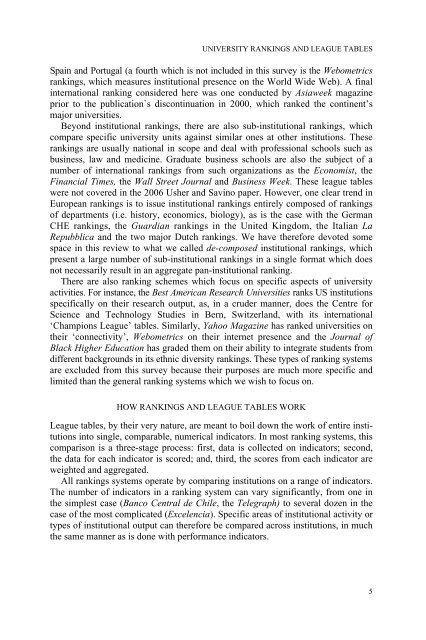University Rankings, Diversity, and the New ... - Sense Publishers
University Rankings, Diversity, and the New ... - Sense Publishers
University Rankings, Diversity, and the New ... - Sense Publishers
Create successful ePaper yourself
Turn your PDF publications into a flip-book with our unique Google optimized e-Paper software.
UNIVERSITY RANKINGS AND LEAGUE TABLES<br />
Spain <strong>and</strong> Portugal (a fourth which is not included in this survey is <strong>the</strong> Webometrics<br />
rankings, which measures institutional presence on <strong>the</strong> World Wide Web). A final<br />
international ranking considered here was one conducted by Asiaweek magazine<br />
prior to <strong>the</strong> publication`s discontinuation in 2000, which ranked <strong>the</strong> continent’s<br />
major universities.<br />
Beyond institutional rankings, <strong>the</strong>re are also sub-institutional rankings, which<br />
compare specific university units against similar ones at o<strong>the</strong>r institutions. These<br />
rankings are usually national in scope <strong>and</strong> deal with professional schools such as<br />
business, law <strong>and</strong> medicine. Graduate business schools are also <strong>the</strong> subject of a<br />
number of international rankings from such organizations as <strong>the</strong> Economist, <strong>the</strong><br />
Financial Times, <strong>the</strong> Wall Street Journal <strong>and</strong> Business Week. These league tables<br />
were not covered in <strong>the</strong> 2006 Usher <strong>and</strong> Savino paper. However, one clear trend in<br />
European rankings is to issue institutional rankings entirely composed of rankings<br />
of departments (i.e. history, economics, biology), as is <strong>the</strong> case with <strong>the</strong> German<br />
CHE rankings, <strong>the</strong> Guardian rankings in <strong>the</strong> United Kingdom, <strong>the</strong> Italian La<br />
Repubblica <strong>and</strong> <strong>the</strong> two major Dutch rankings. We have <strong>the</strong>refore devoted some<br />
space in this review to what we called de-composed institutional rankings, which<br />
present a large number of sub-institutional rankings in a single format which does<br />
not necessarily result in an aggregate pan-institutional ranking.<br />
There are also ranking schemes which focus on specific aspects of university<br />
activities. For instance, <strong>the</strong> Best American Research Universities ranks US institutions<br />
specifically on <strong>the</strong>ir research output, as, in a cruder manner, does <strong>the</strong> Centre for<br />
Science <strong>and</strong> Technology Studies in Bern, Switzerl<strong>and</strong>, with its international<br />
‘Champions League’ tables. Similarly, Yahoo Magazine has ranked universities on<br />
<strong>the</strong>ir ‘connectivity’, Webometrics on <strong>the</strong>ir internet presence <strong>and</strong> <strong>the</strong> Journal of<br />
Black Higher Education has graded <strong>the</strong>m on <strong>the</strong>ir ability to integrate students from<br />
different backgrounds in its ethnic diversity rankings. These types of ranking systems<br />
are excluded from this survey because <strong>the</strong>ir purposes are much more specific <strong>and</strong><br />
limited than <strong>the</strong> general ranking systems which we wish to focus on.<br />
HOW RANKINGS AND LEAGUE TABLES WORK<br />
League tables, by <strong>the</strong>ir very nature, are meant to boil down <strong>the</strong> work of entire institutions<br />
into single, comparable, numerical indicators. In most ranking systems, this<br />
comparison is a three-stage process: first, data is collected on indicators; second,<br />
<strong>the</strong> data for each indicator is scored; <strong>and</strong>, third, <strong>the</strong> scores from each indicator are<br />
weighted <strong>and</strong> aggregated.<br />
All rankings systems operate by comparing institutions on a range of indicators.<br />
The number of indicators in a ranking system can vary significantly, from one in<br />
<strong>the</strong> simplest case (Banco Central de Chile, <strong>the</strong> Telegraph) to several dozen in <strong>the</strong><br />
case of <strong>the</strong> most complicated (Excelencia). Specific areas of institutional activity or<br />
types of institutional output can <strong>the</strong>refore be compared across institutions, in much<br />
<strong>the</strong> same manner as is done with performance indicators.<br />
5














